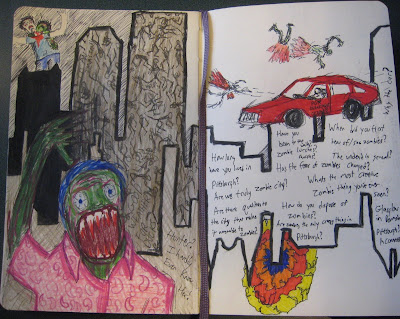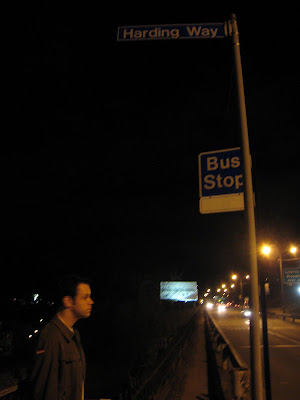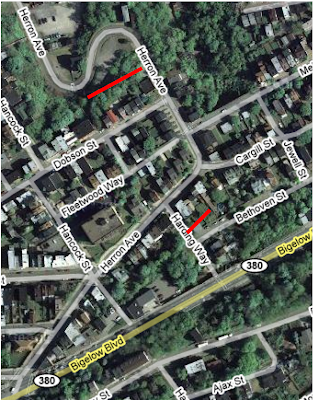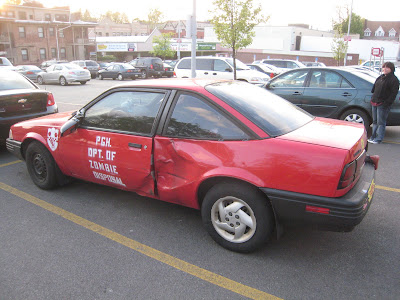
Since time before time (and by that I mean the early 1970s), Pittsburgh has been a town of zombies. More recently, one can see a beat up red little car around town, upon whose sides is stenciled the seal of the City of Pittsburgh, and the words "PITTSBURGH DEPARTMENT OF ZOMBIE DISPOSAL"
I recently interviewed Eve, the owner of the vehicle, at her place of employment,
Heads Together, Squirrel Hill's last independent video rental store.
"Part of its just to entertain people in traffic," she thinks. "Like there's a suburban mom who's really frustrated and she sees my car with the zombie in the back and goes 'Oh, thats lovely!' "
Eve was born in Pittsburgh, and has lived here her whole life. She's known about zombies for just as long. She attributes her interest in zombies to
George Romero's many zombie films, especially Dawn of the Dead, filmed locally at the Monroeville Mall. All of Romero's zombie films were filmed in and around Pittsburgh, and the most recent one (
Land of the Dead) took explicit advantage of Pittsburgh's geography in its plot- the Golden Triangle has returned to being a fort- its rivers serve as barriers against the zombie threat.
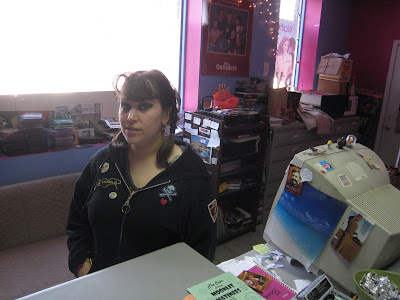
Eve gave me a brief history of zombie lore in America and Hollywood.
"My friend Greg who works over at the
Warhol was in Haiti in the peace corps for a couple of years. He was in this small village, and people were dead serious, they told him not to go near this one guy because he was a zombie. He was just this slow lumbering kind of guy in the village. There's a whole thing in the Hattian religion where you get turned into a zombie when a
Bokor (sorcerer or shaman) blows pufferfish powder on you. You go into a coma, get a fair amount of brain damage, and he digs you up, and then you have to go work on his farm the rest of your life.
"That was pretty much how the zombie thing started out, a small piece of the
Vodou religion, but then when Hollywood got a hold of it they started having magic zombies, and atomic zombies, and biological zombies. No going through the whole vodou or
loa thing, we'll just have some guy cut up a chicken and then the zombies will come. If you watch "
I Eat Your Skin", they almost get it right, but then it gets silly.
"Zombies didn't really start eating people until then. Before that, if you saw "
White Zombie" with Bela Lugosi he's just kind of sad, and maybe he strangled people. But zombies didn't start eating people until the 60s or 70s.
I asked her about more recent films where biological viruses change humans and make them scary and zombie-like. Do the dark-seekers in
I Am Legend count? Or the virus-ridden humans in the
28 Days Later series. Her answer was a clear no. "They are rage-infected humans, they aren't zombies. Zombies have to be dead and come back to life to qualify, however unlikely the circumstances that lead up to that."
She got a bit into the motifs and themes zombies might represent in movies. More recent ones cast them as the human output of a biological or chemical attack, but earlier films were more classist.
"There might be" Eve says, "a blue-collar connection, or maybe they are representative of slacker ner-do-wells. Zombies represent the masses- they're blue collar- they just keep going. It's like working on a fab-line. Mindless, repetitive action. I think anyone in the customer service industry can appreciate the zombie mentality."
These undead were the impetus for a group Halloween costume she and her friends put together a few years ago. They bought cheap jumpsuits and stenciled "Pittsburgh Department of Zombie Disposal" on the back of them. Add improvised weapons to the mix (The crowbar is Eve's favorite) and the PDZD was born. "I think," she says "that if the PDZD were real they would be a cross between garbagemen and animal control."
A few weeks later, Eve took it upon herself to further stencil her car with the logo. At the time, it was a hunter blue geo prism. This "ZombieMobile Mark 1" was destroyed when it was rear-ended over on Schenley Hill. Mark 2 is the new red one, which she purchased from her mechanic.
Her car is part of a growing trend.
"I think that anyone in the know knows that Pittsburgh is the zombie city. I think right now there is a huge ressurgance in zombies- its a weird culture catching on. All the goths wanted to be vampires, but now they are okay with being less pretentious and emotional."
The big event every year is the
zombie walk in the Monroeville Mall. Both this year and last year it made the Guinness Book of World Records as the largest zombie shuffle.
That walk and others are put on by local group
The It's Alive! Show. Thousands of people show up in zombie costume, although the most creative zombie Eve has ever seen was one of the zombie bunnies her friend Beth has knit over the years.
When we spoke about the reaction of other municipal departments in Pittsburgh ("Ambulance drivers seem to get a chuckle. Garbage men get a kick out of it too!") the conversation shifted to how Pittsburgh's topography.
The post-industrial landscape makes a huge impact on the genre- most zombie/plague films have been set in Pittsburgh or post-industrial Scotland, a similar landscape.
"Pittsburgh and Scotland share a weird connection- apparently we both have the same slang. Metal industries and the Carnegie connection. Maybe he started it. "I've imported some bog mummies to work in the factories!" and then they busted loose."
She talked about other strange things in our city as well, including the Ogua- giant catfish that date back from Indian times in the three rivers.
"I used to boat around on the river, and I've seen some pretty big catfish. Like, you smack one with a paddle, and they start trying to rock the boat. There are also a lot of weird religious shrines in Pittsburgh: There used to be a huge Indian burial mound downtown, near the Blvd. of the Allies; to Hindu people the Point is hugely auspicious.
"But there's also the parkway Virgin Mary shrine, which is really nice. It seems like every culture that came here brought a lot with them. And then they got into competition- you'll go to a neighborhood and there will be 80 churches. St. Anthony's on Troy Hill has over 5000 relics and reliquaries.
"Taking three lefts here is never the same as taking one right. You end up four neighborhoods over right next to another church.
"Over at the Safar Center for Resuscitation Research at the University of Pittsburgh they are actually doing
research on dogs right now where they pump all their fluids out and stop their hearts and then start them again. It was a
Russian experiment in the 1940s, and they are trying it again."
Finally, I asked Eve how the PDZD disposes of the zombies it is called in to take away.
""If it's not too aggressive we might use a have-a-heart trap. We'd bait it with some head cheese. Then of course we would release the zombie into the wild of Monroeville, it's natural habitat behind the mall, where it can live free with its own kind. The zombies haven't been a big problem since the 70s. Its very rare that we have to put a zombie down. Decapitation is always a winner, but my preferred method is a crowbar to the cranial fissure there. And remember children, if you see a zombie, TELL AN ADULT!"
